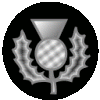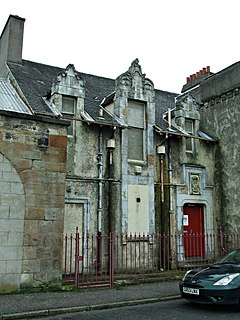
The 9th (Scottish) Division, was an infantry division of the British Army during the First World War, one of the Kitchener's Army divisions raised from volunteers by Lord Kitchener to serve on the Western Front during the First World War.
The hackle is a clipped feather plume that is attached to a military headdress.

The 52nd Lowland Volunteers is a battalion in the British Army's Army Reserve or reserve force in the Scottish Lowlands, forming the 6th Battalion of the Royal Regiment of Scotland, also known as 6 SCOTS. Due to its erstwhile association with the 1st Regiment of Foot, it is the senior Reserve line infantry battalion in the British Army. It is one of two Reserve battalions in the Royal Regiment of Scotland, along with 51st Highland, a similar unit located in the Scottish Highlands.

The 51st Highland Volunteers is a battalion in the British Army's Army Reserve or reserve force in the Scottish Highlands, forming the 7th Battalion of the Royal Regiment of Scotland, also known as 7 SCOTS. It is one of two Reserve battalions in the Royal Regiment of Scotland, along with 52nd Lowland, a similar unit located in the Scottish Lowlands.

The Scottish Division was a British Army Infantry command, training and administrative apparatus designated for all Scottish line infantry units. It merged with the Prince of Wales' Division, to form the Scottish, Welsh and Irish Division in 2017.

A Scottish regiment is any regiment that at some time in its history has or had a name that referred to Scotland or some part, thereof, and adopted items of Scottish dress. These regiments were created after the Acts of Union in 1707 between England and Scotland, either directly serving Britain during its various wars, or as part of the military establishments of Commonwealth countries. Their "Scottishness" is no longer necessarily due to recruitment in Scotland nor any proportion of members of Scottish ancestry. Traditionally, Scottish regiments cultivate a reputation of exceptional fierceness in combat and are often given romantic portrayals in popular media. Within Scotland, itself, regiments of the Scottish Lowlands did not adopt as distinctively "Scottish" uniforms until the late Victorian Era and even then the kilt, that most distinctive aspect of the Highland soldier, was not adopted wholesale.
The 28th Infantry Brigade was a British Army formation which served during the First World War, the Second World War, the Korean War, The Malayan Emergency and Indonesian Confrontation.

The Glasgow Highlanders was a former infantry regiment of the British Army, part of the Territorial Force, later renamed the Territorial Army. The regiment eventually became a Volunteer Battalion of the Highland Light Infantry in 1881. The regiment saw active service in both World War I and World War II. In 1959 the Highland Light Infantry was amalgamated with the Royal Scots Fusiliers to form the Royal Highland Fusiliers. The Glasgow Highlanders was later amalgamated into the 52nd Lowland Volunteers in 1967.

The Royal Regiment of Scotland is the senior and only Scottish line infantry regiment of the British Army Infantry. It consists of four regular and two reserve battalions, plus an incremental company, each formerly an individual regiment. However, each battalion maintains its former regimental pipes and drums to carry on the traditions of their antecedent regiments.
When a World War I medal was issued to a member of Commonwealth forces, it was issued with a Service Number, Rank, Name and Regiment. This information should be on every medal that was issued during the First World War.
A large regiment is a multi-battalion infantry formation of the British Army. First formed in the 1960s, large regiments are the result of the amalgamation of three or more existing single-battalion regiments, and perpetuate the traditions of each of the predecessor units.
During the First World War the British Armed Forces was enlarged to many times its peacetime strength. This was done mainly by adding new battalions to existing regiments. Although sometimes identified by shoulder titles, generally the new battalions could not be identified from appearance. Consequently, the units in this list have been assembled considering only those as having a uniquely different cap badge.

The 156th Brigade was an infantry brigade formation of the British Army. The brigade saw active service in both World War I and World War II with the 52nd (Lowland) Division.

The 155th Brigade was an infantry brigade of the British Army that saw active service in both World War I and World War II. Assigned to the 52nd (Lowland) Division, the brigade saw active service in the Middle East and on the Western Front during the First World War. During the Second World War, now the 155th Infantry Brigade, it continued to serve with the 52nd Division in Operation Dynamo, and later in North-western Europe from late 1944 until May 1945.

The 157th Brigade was an infantry brigade of the British Army. The brigade fought in both World War I and World War II, assigned to 52nd (Lowland) Division.
The 1915 Birthday Honours were appointments by King George V to various orders and honours to reward and highlight good works by citizens of the British Empire. The appointments were made to celebrate the official birthday of The King, and were published in The London Gazette and in The Times on 3 June 1915.

Paisley Barracks was a military installation in Paisley, Renfrewshire.
The Glasgow Brigade was an infantry formation of Britain's Volunteer Force from 1890 to 1902. It was the forerunner of two formations of the Territorial Force that saw service in both World Wars.
The Forth Brigade was a Scottish infantry formation of Britain's Volunteer Force from 1888 to 1902.








